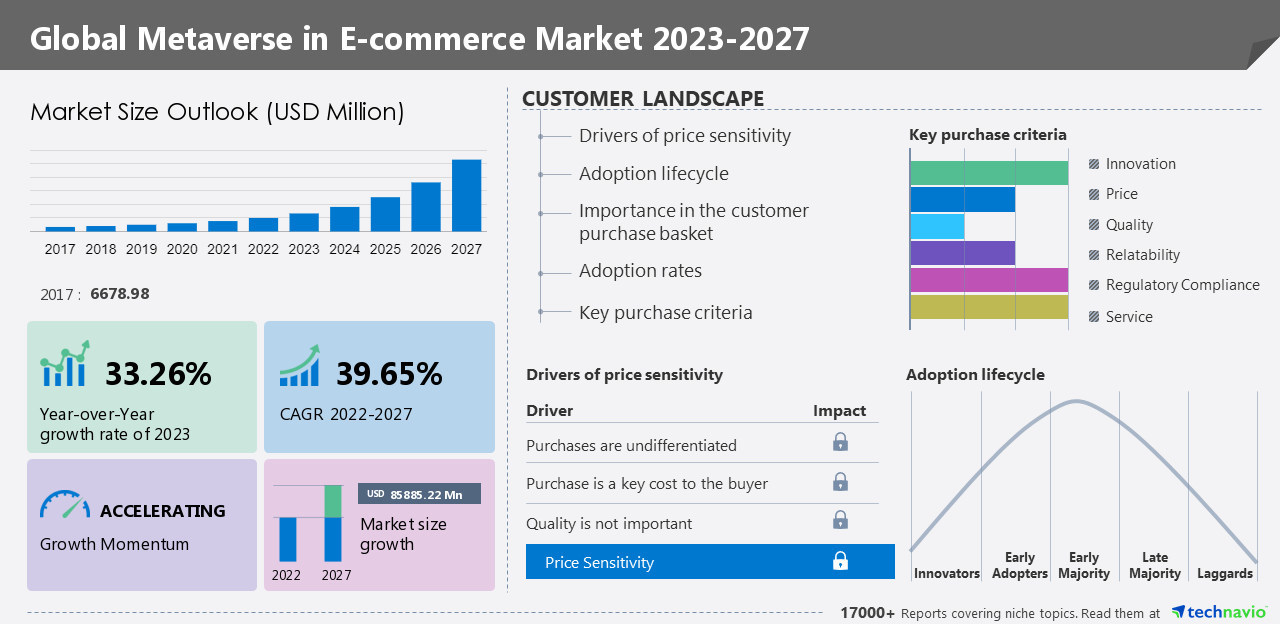NEW YORK – According to Technavio, the global metaverse in e-commerce market size is expected to grow by USD 85,885.22 million from 2022 to 2027. The market is estimated to grow at a CAGR of 39.65% during the forecast period. Moreover, the growth momentum will accelerate. North America will account for 39% of the growth of the global market during the forecast period.
Global Metaverse in E-commerce Market – Five Forces
The global metaverse in e-commerce market is fragmented, and the five forces analysis covers–
- Bargaining power of buyers
- Threat of new entrants
- Threat of rivalry
- Bargaining power of suppliers
- Threat of substitutes
Global Metaverse in E-commerce Market – Parent Market Analysis
Technavio categorizes the global metaverse in e-commerce market as a part of the information technology (IT) spending market, which covers revenue generated from the sales and subscription of IT services, communications services, cloud services, IT hardware, and IT software. Technavio calculates the global IT spending market size based on IT solutions spending by various end-user industries such as healthcare; banking, financial services, and insurance (BFSI); retail; transportation; media and entertainment; and construction.
Global Metaverse in E-commerce Market – Customer Landscape
The report includes the market’s adoption lifecycle, from the innovator’s stage to the laggard’s stage. It focuses on adoption rates in different regions based on the penetration. Furthermore, the report also includes key purchase criteria and drivers of price sensitivity to help companies evaluate and develop their growth strategies.
Global Metaverse in E-commerce Market – Segmentation Assessment
Segment Overview
Technavio has segmented the market based on platform, technology, and region.
- The computer segment will grow at the highest rate during the forecast period. The segment had the largest share in the global metaverse in the e-commerce market in 2022 due to the rising internet penetration. Many websites are built to be accessed by desktops. Moreover, consumers with faster Internet speeds tend to prefer desktops, as a fixed connection is faster than a mobile one. These factors will drive the growth of the segment during the forecast period.
Geography Overview
Based on geography, the global metaverse in the e-commerce market is segmented into North America, Europe, APAC, South America, and the Middle East and Africa. The report provides actionable insights and estimates the contribution of all regions to the growth of the global metaverse in the e-commerce market.
- North America will account for 39% of the global metaverse in the e-commerce market during the forecast period. The growth of the market in the region is attributed to factors such as increasing investments in AR technology, rising adoption of technologically advanced applications, and advanced research activities. Moreover, the US and Canada have a vast internet infrastructure and a large number of smartphone users and online stores, which will further contribute to the market’s growth.
Global Metaverse in E-commerce Market – Market Dynamics
Key factors driving market growth
- The growing popularity of AR technology is driving market growth. This technology provides various benefits to customers and merchants.
- Many e-commerce businesses are adopting AR technology. For instance, Amazon.com Inc. is incorporating VR and AR into its shopping experience.
- Metaverse in e-commerce will enable customers to make purchases in real-time at life-like virtual stores created by sellers.
- Such factors will contribute to market growth during the forecast period.
Recent trends influencing the market
- Growing smartphone penetration and the use of 5G are key trends in the metaverse in the e-commerce market.
- Moreover, with the rise in the adoption of smart devices such as smartphones, the demand for 5G is increasing. This, in turn, will increase demand for 5G equipment.
- The growth in smartphone penetration has also led to a rise in online shopping and the use of social media platforms. This will increase the use of different apps and online platforms for online shopping, which will drive the growth of the e-commerce industry during the forecast period.
- Furthermore, the availability of such high-speed internet will encourage e-commerce businesses to adopt advanced technologies such as metaverse to enhance the customers’ experience.
- These factors are expected to drive the growth of the global metaverse in the e-commerce market during the forecast period.
Major challenges hindering market growth
- Privacy and security concerns regarding the metaverse are challenging the growth of the metaverse in the e-commerce market.
- The metaverse collects and processes large amounts of information about users, which leads to privacy concerns.
- Moreover, security or privacy violations might harm the reputation of an organization.
- As the metaverse is constantly evolving, organizers are concerned about the security of these platforms.
- Such factors may hamper the growth of the market during the forecast period.
What are the key data covered in this metaverse in e-commerce market report?
- CAGR of the market during the forecast period
- Detailed information on factors that will drive the growth of the metaverse in e-commerce market between 2023 and 2027
- Precise estimation of the size of the metaverse in e-commerce market and its contribution to the parent market
- Accurate predictions about upcoming trends and changes in consumer behavior
- Growth of the metaverse in e-commerce market across APAC, North America, Europe, Middle East and Africa, and South America
- Thorough analysis of the market’s competitive landscape and detailed information about vendors
- Comprehensive analysis of factors that will challenge the growth of metaverse in e-commerce market vendors
Source: Technavio





